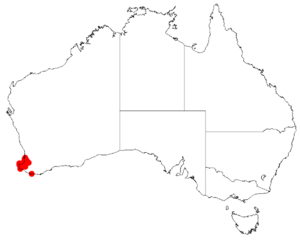Acacia semitrullata facts for kids
Quick facts for kids Acacia semitrullata |
|
|---|---|
| Conservation status | |
| Scientific classification | |
| Genus: |
Acacia
|
| Species: |
semitrullata
|
 |
|
| Occurrence data from AVH | |
The Acacia semitrullata is a type of shrub. It belongs to the Acacia family, also known as wattles. This plant is special because it only grows in one place: the southwestern part of Australia. When a plant or animal only lives in one specific area, it is called endemic.
What it Looks Like
This Acacia is a thin, upright shrub. It usually grows to be about 0.2 to 0.7 meters (or 8 inches to 2 feet) tall. Its branches are orange-brown. The smaller twigs have tiny hairs. It also has small, triangular leaf-like parts called stipules, which are about 1 to 2 millimeters long.
Most Acacia plants, including this one, do not have true leaves. Instead, they have something called phyllodes. These phyllodes look like leaves but are actually flattened stems. The phyllodes on Acacia semitrullata are stiff and green. They are shaped a bit like a triangle and are about 5 to 10 millimeters long and 1.3 to 2 millimeters wide. Each phyllode has a clear line down the middle.
This shrub produces cream-white flowers. You can see them blooming from May to October.
Its Name and History
A botanist named Bruce Maslin first officially described this plant in 1978. He wrote about it in a science journal called Nuytsia.
For a short time, in 2003, another botanist named Leslie Pedley gave it a different scientific name, Racosperma semitrullatum. But by 2006, it was moved back to its original Acacia name.
Where it Grows
The Acacia semitrullata grows in a small part of the South West region of Western Australia. You can often find it in sandy areas or wet, swampy places. It grows well in clay or sandy soils. Sometimes, these soils are found over a type of hard, reddish soil called laterite.
This shrub's natural home stretches from near Yarloop in the north. It goes down to areas around Collie and the Whicher Range in the south. It likes to grow in open areas with low shrubs, especially around swamps. It can also be found in open Jarrah forest communities.
Images for kids



